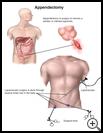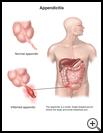
Appendectomy in Children and Teens (Removal of Appendix)
________________________________________________________________________
KEY POINTS
- An appendectomy is surgery to remove the appendix, usually because it is swollen, infected, or has an abscess.
- Ask your child’s healthcare provider how long it will take to recover and how to take care of your child at home.
- Make sure you know what symptoms or problems you should watch for and what to do if your child has them.
________________________________________________________________________
What is an appendectomy?
An appendectomy is surgery to remove the appendix, usually because it is swollen, infected, or has an abscess. The appendix is a small finger-shaped pouch where the large and small intestines join together. Healthcare providers are not sure what the appendix does. Removing it does not seem to affect your child’s health.
Swelling and irritation of the appendix is called appendicitis.
When is it used?
An appendectomy may be a planned procedure to treat these problems:
- Your child’s appendix is infected.
- Your child has an abscess of the appendix, which is a pocket of pus, or a solid mass of inflamed tissue (phlegmon)
- Your child’s healthcare provider may insert a small plastic tube near the abscess to drain the pus
- Your child’s provider will give your child antibiotic medicine to treat the infection, the abscess, or the inflamed tissue. Your child’s provider will remove the appendix as a planned surgery later. This is called an interval or delayed appendectomy. Usually the planned surgery is done at least 6 weeks after your child has taken antibiotic medicine and is feeling better.
Imaging is used to confirm the diagnosis and may include:
- Ultrasound, which uses sound waves to show pictures of the belly
- MRI, which uses a strong magnetic field and radio waves to show detailed pictures of the belly
- CT scan, which uses X-rays and a computer to show detailed pictures of the belly
Your older child or teen may have a pregnancy test or a pelvic exam to check for uterine or ectopic pregnancy, miscarriage, infection of the pelvic organs (PID), or a problem with the ovaries.
It is important to get treatment for appendicitis before the appendix ruptures. A rupture is a break or tear in the appendix. If an infected appendix breaks open, it can cause a life-threatening infection in the belly, which is an emergency.
How do I prepare my child for this procedure?
Often an appendectomy is an emergency procedure and there is no time to prepare. If you do have time to prepare before the surgery:
- This surgery may be done as an outpatient or inpatient procedure. This means that your child may be able to go home the same day as the surgery, or your child may be in the hospital for one or more days. Talk to your child’s healthcare provider about where your child will have surgery.
- Your child may or may not need to take regular medicines the day of the procedure. Tell your child’s healthcare provider about all medicines and supplements your child takes. Some products may increase the risk of side effects. Ask your child’s healthcare provider if your child needs to avoid taking any medicine or supplements before the procedure.
- Tell your child’s healthcare provider if your child has any food, medicine, or other allergies such as latex.
- Your child’s provider will tell you when your child needs to stop eating and drinking before the procedure. This helps to keep your child from vomiting during the procedure.
- Tell your child’s provider if your child has an infection such as a cold.
- Follow any other instructions your child’s healthcare provider may give you.
- Ask any questions you have before the procedure. You should understand what your child’s healthcare provider is going to do. You have the right to make decisions about your child’s healthcare and to give permission for any tests or procedures.
What happens during the procedure?
Your child will be given a general anesthetic to prevent pain during the procedure. General anesthesia relaxes the muscles and puts your child into a deep sleep.
The appendix may be removed with either laparoscopic or open surgery:
- Laparoscopic surgery is done through several small cuts in the belly. A laparoscope is a lighted tube with a camera. Your child’s provider can put the scope and tools into your child’s belly through the small cuts to look inside the and remove the appendix. This may not be done if your child’s appendix has ruptured.
- Open surgery is done with one larger cut in your child’s lower right belly. The cut is usually about 2 to 3 inches long.
Your child’s surgeon may put a tube in the wound to collect blood, pus, and other fluids that drain from a wound after surgery. Your child’s surgeon will close the wound with stitches.
- Your child’s provider may prescribe medicine to:
- Treat pain
- Treat or prevent an infection
- Treat or prevent side effects such as nausea or constipation
- Soften stool and reduce straining with a bowel movement
Your child’s provider may recommend other types of therapy to help relieve pain or other symptoms.
What happens after the procedure?
If your child’s appendix ruptured or your child has an infection, your child may need to stay in the hospital longer and it will take more time to recover. If your child has a drainage tube, it will be removed when the drainage has stopped. Your child may need antibiotic medicine and fluids through an IV.
Follow your child’s healthcare provider's instructions. If an antibiotic medicine has been prescribed when your child goes go home, give it for as long as prescribed, even if your child feels better.
Follow your child’s healthcare provider's instructions. Ask your child’s provider:
- How long it will take for your child to recover
- If there are activities your child should avoid and when your child can return to normal activities
- How to take care of your child at home
- What symptoms or problems you should watch for and what to do if your child has them
Make sure you know when your child should come back for a checkup. Keep all appointments for provider visits or tests.
What are the risks of this procedure?
Every procedure or treatment has risks. Some possible risks of this procedure include:
- Your child may have problems with anesthesia.
- Your child may have an infection or bleeding.
Ask your child’s healthcare provider how these risks apply to your child. Be sure to discuss any other questions or concerns that you may have.
Last modified: 2021-12-07
Last reviewed: 2020-06-26


